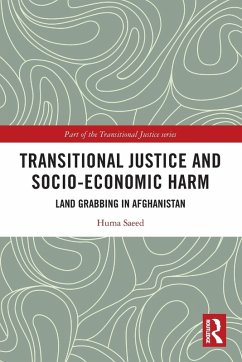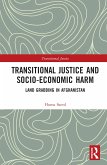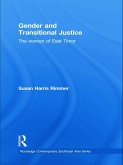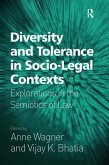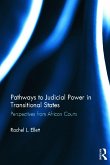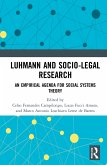- Broschiertes Buch
- Merkliste
- Auf die Merkliste
- Bewerten Bewerten
- Teilen
- Produkt teilen
- Produkterinnerung
- Produkterinnerung
Maintaining the importance of socio-economic issues in devising transitional justice mechanisms, this book examines the widespread practice of land grabbing in Afghanistan.
Andere Kunden interessierten sich auch für
![Transitional Justice and Socio-Economic Harm Transitional Justice and Socio-Economic Harm]() Huma SaeedTransitional Justice and Socio-Economic Harm195,99 €
Huma SaeedTransitional Justice and Socio-Economic Harm195,99 €![Gender and Transitional Justice Gender and Transitional Justice]() Susan Harris RimmerGender and Transitional Justice67,99 €
Susan Harris RimmerGender and Transitional Justice67,99 €![Diversity and Tolerance in Socio-Legal Contexts Diversity and Tolerance in Socio-Legal Contexts]() Vijay K. BhatiaDiversity and Tolerance in Socio-Legal Contexts206,99 €
Vijay K. BhatiaDiversity and Tolerance in Socio-Legal Contexts206,99 €![Socio-Legal Integration Socio-Legal Integration]() Agnieszka KubalSocio-Legal Integration76,99 €
Agnieszka KubalSocio-Legal Integration76,99 €![Pathways to Judicial Power in Transitional States Pathways to Judicial Power in Transitional States]() Rachel EllettPathways to Judicial Power in Transitional States206,99 €
Rachel EllettPathways to Judicial Power in Transitional States206,99 €![Luhmann and Socio-Legal Research Luhmann and Socio-Legal Research]() Luhmann and Socio-Legal Research216,99 €
Luhmann and Socio-Legal Research216,99 €![Socio-Legal Integration Socio-Legal Integration]() Agnieszka KubalSocio-Legal Integration206,99 €
Agnieszka KubalSocio-Legal Integration206,99 €-
-
-
Maintaining the importance of socio-economic issues in devising transitional justice mechanisms, this book examines the widespread practice of land grabbing in Afghanistan.
Hinweis: Dieser Artikel kann nur an eine deutsche Lieferadresse ausgeliefert werden.
Hinweis: Dieser Artikel kann nur an eine deutsche Lieferadresse ausgeliefert werden.
Produktdetails
- Produktdetails
- Verlag: Routledge
- Seitenzahl: 218
- Erscheinungstermin: 27. Mai 2024
- Englisch
- Abmessung: 234mm x 156mm x 12mm
- Gewicht: 339g
- ISBN-13: 9780367681364
- ISBN-10: 0367681366
- Artikelnr.: 70353746
- Herstellerkennzeichnung
- Libri GmbH
- Europaallee 1
- 36244 Bad Hersfeld
- gpsr@libri.de
- Verlag: Routledge
- Seitenzahl: 218
- Erscheinungstermin: 27. Mai 2024
- Englisch
- Abmessung: 234mm x 156mm x 12mm
- Gewicht: 339g
- ISBN-13: 9780367681364
- ISBN-10: 0367681366
- Artikelnr.: 70353746
- Herstellerkennzeichnung
- Libri GmbH
- Europaallee 1
- 36244 Bad Hersfeld
- gpsr@libri.de
Huma Saeed is an affiliated senior researcher at the Leuven Institute of Criminology, Belgium, and an independent consultant on transitional justice and human rights.
Preface and acknowledgments
Introduction: Setting the scene
A land-grabbing case in the Sherpur neighborhood of Kabul
Relevance of Sherpur for the current study
Sherpur and beyond
Research aim
Introduction to the conceptual framework
Critical criminology
Transitional justice
Introduction to the empirical component
Methodology
Desk research
Fieldwork
Data analysis
Ethical considerations
Research limitations and challenges
Security
Data saturation
Validity and reliability
Researcher's positionality
Emotional challenges of the data analysis
Book structure
References
1 Socio-economic harm in violent conflicts, transitional justice and
critical criminology
Socio-economic harm in times of violent conflicts
Socio-economic harm, transitional justice and criminology
Transitional justice and socio-economic harm
Transitional justice and development
Transitional justice and structural inequality: A move towards
transformative justice
Critical criminology and a harm-based approach to crime
Critical criminology
An understanding of crime
Harm-based approach to crime
State crime
Approaches to state crime
State crimes as serious human rights violations
Approaches to economic crime in criminology
Conclusion
References
2 Housing, Land and Property (HLP) loss in violent conflict
The right to adequate housing in the human rights regime
HLP rights violation in violent conflicts and peace settlements
Land grabbing and transitional justice
Land dispute, urbanization and criminology
Conclusion
References
3 Violent conflict, socio-economic harm and transitional justice in
Afghanistan
Conflict background
The Bonn Agreement
Transitional justice in Afghanistan
"A Call for Justice"
The Action Plan for Peace, Reconciliation and Justice
Bottom-up approach to transitional justice
The impact of violent conflict on the socio-economic fabric of the Afghan
society
Market economy and liberal peacebuilding in Afghanistan
Conclusion
References
4 Housing, Land and Property rights in Afghanistan
Background and legal framework for HLP rights in Afghanistan
HLP rights, women and the marginalized population
Land titling and registration
Land dispute mechanisms in Afghanistan
Conflict impact on HLP rights in Afghanistan
The returnee IDPs' perception on HLP harm
The returnees' perception on HLP harm
Perceptions of victims of land grabbing
Conclusion
References
5 Land grabbing in Afghanistan
General background and definition of land grabbing in Afghanistan
Definition of land grabbing in Afghanistan
Land grabbing in the Afghan law
Tackling land grabbing in practice
The Strategic Plan to combat land grabbing
Other measures by the government to tackle land grabbing
Conclusion
References
6 Land grabbing in Afghanistan, economic-state crime and transitional
justice
Land grabbing as economic crime
The actor
The motive behind the act
The contextual factors and means employed
The consequences and harm
Land grabbing as state crime
State crimes of commission
State crimes of negligence
State crime by omission
Land grabbing as economic-state crime
Transitional justice and land grabbing
Land grabbing and impunity
Land grabbing and property restitution/provision to the IDPs and returnees
Land grabbing as serious human rights violations
Quality (the degree of gravity)
Quantity (level of frequency)
Conclusion
References
7 Transitional justice and criminology: Bridging the gap
Through the prism of crime
The gap between criminology and transitional justice
Towards bridging the gap by combining fieldwork and an interdisciplinary
approach
Crime as injury and social harm
State crime victims
Through the methodological prism
Conclusion
References
Conclusion
Main argument and research contribution
Recommendations
Recommendations for future research
References
Appendix A: Questionnaire
Appendix B: List of interviews
Index
Introduction: Setting the scene
A land-grabbing case in the Sherpur neighborhood of Kabul
Relevance of Sherpur for the current study
Sherpur and beyond
Research aim
Introduction to the conceptual framework
Critical criminology
Transitional justice
Introduction to the empirical component
Methodology
Desk research
Fieldwork
Data analysis
Ethical considerations
Research limitations and challenges
Security
Data saturation
Validity and reliability
Researcher's positionality
Emotional challenges of the data analysis
Book structure
References
1 Socio-economic harm in violent conflicts, transitional justice and
critical criminology
Socio-economic harm in times of violent conflicts
Socio-economic harm, transitional justice and criminology
Transitional justice and socio-economic harm
Transitional justice and development
Transitional justice and structural inequality: A move towards
transformative justice
Critical criminology and a harm-based approach to crime
Critical criminology
An understanding of crime
Harm-based approach to crime
State crime
Approaches to state crime
State crimes as serious human rights violations
Approaches to economic crime in criminology
Conclusion
References
2 Housing, Land and Property (HLP) loss in violent conflict
The right to adequate housing in the human rights regime
HLP rights violation in violent conflicts and peace settlements
Land grabbing and transitional justice
Land dispute, urbanization and criminology
Conclusion
References
3 Violent conflict, socio-economic harm and transitional justice in
Afghanistan
Conflict background
The Bonn Agreement
Transitional justice in Afghanistan
"A Call for Justice"
The Action Plan for Peace, Reconciliation and Justice
Bottom-up approach to transitional justice
The impact of violent conflict on the socio-economic fabric of the Afghan
society
Market economy and liberal peacebuilding in Afghanistan
Conclusion
References
4 Housing, Land and Property rights in Afghanistan
Background and legal framework for HLP rights in Afghanistan
HLP rights, women and the marginalized population
Land titling and registration
Land dispute mechanisms in Afghanistan
Conflict impact on HLP rights in Afghanistan
The returnee IDPs' perception on HLP harm
The returnees' perception on HLP harm
Perceptions of victims of land grabbing
Conclusion
References
5 Land grabbing in Afghanistan
General background and definition of land grabbing in Afghanistan
Definition of land grabbing in Afghanistan
Land grabbing in the Afghan law
Tackling land grabbing in practice
The Strategic Plan to combat land grabbing
Other measures by the government to tackle land grabbing
Conclusion
References
6 Land grabbing in Afghanistan, economic-state crime and transitional
justice
Land grabbing as economic crime
The actor
The motive behind the act
The contextual factors and means employed
The consequences and harm
Land grabbing as state crime
State crimes of commission
State crimes of negligence
State crime by omission
Land grabbing as economic-state crime
Transitional justice and land grabbing
Land grabbing and impunity
Land grabbing and property restitution/provision to the IDPs and returnees
Land grabbing as serious human rights violations
Quality (the degree of gravity)
Quantity (level of frequency)
Conclusion
References
7 Transitional justice and criminology: Bridging the gap
Through the prism of crime
The gap between criminology and transitional justice
Towards bridging the gap by combining fieldwork and an interdisciplinary
approach
Crime as injury and social harm
State crime victims
Through the methodological prism
Conclusion
References
Conclusion
Main argument and research contribution
Recommendations
Recommendations for future research
References
Appendix A: Questionnaire
Appendix B: List of interviews
Index
Preface and acknowledgments
Introduction: Setting the scene
A land-grabbing case in the Sherpur neighborhood of Kabul
Relevance of Sherpur for the current study
Sherpur and beyond
Research aim
Introduction to the conceptual framework
Critical criminology
Transitional justice
Introduction to the empirical component
Methodology
Desk research
Fieldwork
Data analysis
Ethical considerations
Research limitations and challenges
Security
Data saturation
Validity and reliability
Researcher's positionality
Emotional challenges of the data analysis
Book structure
References
1 Socio-economic harm in violent conflicts, transitional justice and
critical criminology
Socio-economic harm in times of violent conflicts
Socio-economic harm, transitional justice and criminology
Transitional justice and socio-economic harm
Transitional justice and development
Transitional justice and structural inequality: A move towards
transformative justice
Critical criminology and a harm-based approach to crime
Critical criminology
An understanding of crime
Harm-based approach to crime
State crime
Approaches to state crime
State crimes as serious human rights violations
Approaches to economic crime in criminology
Conclusion
References
2 Housing, Land and Property (HLP) loss in violent conflict
The right to adequate housing in the human rights regime
HLP rights violation in violent conflicts and peace settlements
Land grabbing and transitional justice
Land dispute, urbanization and criminology
Conclusion
References
3 Violent conflict, socio-economic harm and transitional justice in
Afghanistan
Conflict background
The Bonn Agreement
Transitional justice in Afghanistan
"A Call for Justice"
The Action Plan for Peace, Reconciliation and Justice
Bottom-up approach to transitional justice
The impact of violent conflict on the socio-economic fabric of the Afghan
society
Market economy and liberal peacebuilding in Afghanistan
Conclusion
References
4 Housing, Land and Property rights in Afghanistan
Background and legal framework for HLP rights in Afghanistan
HLP rights, women and the marginalized population
Land titling and registration
Land dispute mechanisms in Afghanistan
Conflict impact on HLP rights in Afghanistan
The returnee IDPs' perception on HLP harm
The returnees' perception on HLP harm
Perceptions of victims of land grabbing
Conclusion
References
5 Land grabbing in Afghanistan
General background and definition of land grabbing in Afghanistan
Definition of land grabbing in Afghanistan
Land grabbing in the Afghan law
Tackling land grabbing in practice
The Strategic Plan to combat land grabbing
Other measures by the government to tackle land grabbing
Conclusion
References
6 Land grabbing in Afghanistan, economic-state crime and transitional
justice
Land grabbing as economic crime
The actor
The motive behind the act
The contextual factors and means employed
The consequences and harm
Land grabbing as state crime
State crimes of commission
State crimes of negligence
State crime by omission
Land grabbing as economic-state crime
Transitional justice and land grabbing
Land grabbing and impunity
Land grabbing and property restitution/provision to the IDPs and returnees
Land grabbing as serious human rights violations
Quality (the degree of gravity)
Quantity (level of frequency)
Conclusion
References
7 Transitional justice and criminology: Bridging the gap
Through the prism of crime
The gap between criminology and transitional justice
Towards bridging the gap by combining fieldwork and an interdisciplinary
approach
Crime as injury and social harm
State crime victims
Through the methodological prism
Conclusion
References
Conclusion
Main argument and research contribution
Recommendations
Recommendations for future research
References
Appendix A: Questionnaire
Appendix B: List of interviews
Index
Introduction: Setting the scene
A land-grabbing case in the Sherpur neighborhood of Kabul
Relevance of Sherpur for the current study
Sherpur and beyond
Research aim
Introduction to the conceptual framework
Critical criminology
Transitional justice
Introduction to the empirical component
Methodology
Desk research
Fieldwork
Data analysis
Ethical considerations
Research limitations and challenges
Security
Data saturation
Validity and reliability
Researcher's positionality
Emotional challenges of the data analysis
Book structure
References
1 Socio-economic harm in violent conflicts, transitional justice and
critical criminology
Socio-economic harm in times of violent conflicts
Socio-economic harm, transitional justice and criminology
Transitional justice and socio-economic harm
Transitional justice and development
Transitional justice and structural inequality: A move towards
transformative justice
Critical criminology and a harm-based approach to crime
Critical criminology
An understanding of crime
Harm-based approach to crime
State crime
Approaches to state crime
State crimes as serious human rights violations
Approaches to economic crime in criminology
Conclusion
References
2 Housing, Land and Property (HLP) loss in violent conflict
The right to adequate housing in the human rights regime
HLP rights violation in violent conflicts and peace settlements
Land grabbing and transitional justice
Land dispute, urbanization and criminology
Conclusion
References
3 Violent conflict, socio-economic harm and transitional justice in
Afghanistan
Conflict background
The Bonn Agreement
Transitional justice in Afghanistan
"A Call for Justice"
The Action Plan for Peace, Reconciliation and Justice
Bottom-up approach to transitional justice
The impact of violent conflict on the socio-economic fabric of the Afghan
society
Market economy and liberal peacebuilding in Afghanistan
Conclusion
References
4 Housing, Land and Property rights in Afghanistan
Background and legal framework for HLP rights in Afghanistan
HLP rights, women and the marginalized population
Land titling and registration
Land dispute mechanisms in Afghanistan
Conflict impact on HLP rights in Afghanistan
The returnee IDPs' perception on HLP harm
The returnees' perception on HLP harm
Perceptions of victims of land grabbing
Conclusion
References
5 Land grabbing in Afghanistan
General background and definition of land grabbing in Afghanistan
Definition of land grabbing in Afghanistan
Land grabbing in the Afghan law
Tackling land grabbing in practice
The Strategic Plan to combat land grabbing
Other measures by the government to tackle land grabbing
Conclusion
References
6 Land grabbing in Afghanistan, economic-state crime and transitional
justice
Land grabbing as economic crime
The actor
The motive behind the act
The contextual factors and means employed
The consequences and harm
Land grabbing as state crime
State crimes of commission
State crimes of negligence
State crime by omission
Land grabbing as economic-state crime
Transitional justice and land grabbing
Land grabbing and impunity
Land grabbing and property restitution/provision to the IDPs and returnees
Land grabbing as serious human rights violations
Quality (the degree of gravity)
Quantity (level of frequency)
Conclusion
References
7 Transitional justice and criminology: Bridging the gap
Through the prism of crime
The gap between criminology and transitional justice
Towards bridging the gap by combining fieldwork and an interdisciplinary
approach
Crime as injury and social harm
State crime victims
Through the methodological prism
Conclusion
References
Conclusion
Main argument and research contribution
Recommendations
Recommendations for future research
References
Appendix A: Questionnaire
Appendix B: List of interviews
Index

